6 Best Liquid Rubber Foundation Sealants for Ultimate Protection
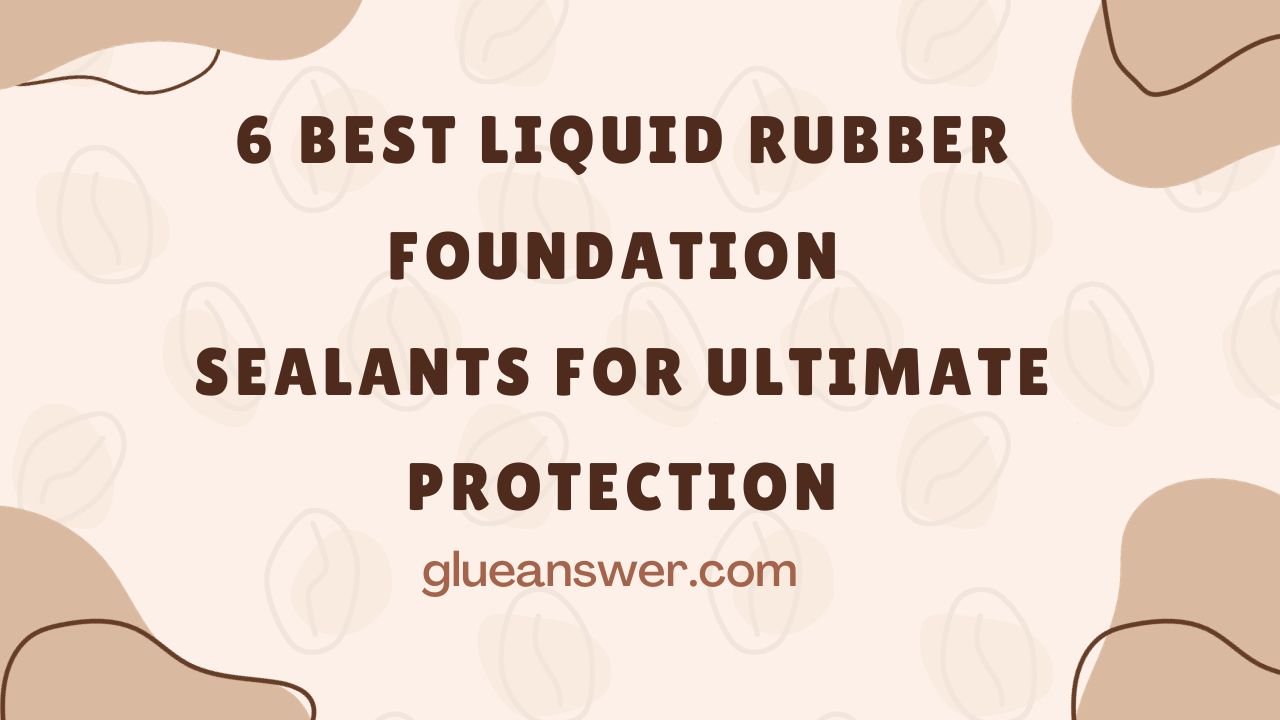
Stop leaks before they start! Discover the best liquid rubber foundation sealant for 2024 and say goodbye to cracks, water damage, and headaches. Our in-depth guide compares top brands like Liquid Rubber, Henry’s Tropicool, Flex Seal,Rubberseal,Gorilla,Rain Guard,Ames,Henry so you can find the perfect sealant for your needs and budget.
Read on to learn about:
- Flexibility: Which sealants move with your foundation to prevent future cracking?
- Waterproofness: Which sealants stand up to the harshest weather conditions?
- Ease of application: Find a sealant that’s DIY-friendly, whether you’re a brush, roller, or sprayer pro.
- Environmental impact: Choose a water-based, solvent-free option for a greener solution.
- Durability: Invest in a sealant that will last for years to come.
Liquid rubber foundation sealant has emerged as a popular and effective solution for waterproofing and protecting the foundations of buildings. This type of sealant is known for its superior flexibility, durability, and adherence properties.
In this article, we will explore some of the best liquid rubber foundation sealants available on the market.
| Features | Flex Seal Liquid Rubber | Rubberseal Liquid Rubber | Gorilla Waterproof Seal | Rain Guard All Porous | Ames Block & Wall Liquid Rubber | BEEST Foundation Sealant |
| Application Methods | Versatile (Brushing, Rolling, Dipping, Pouring) | Roll-on Application | Various (Brushing, Rolling, Troweling, Dipping, Pouring) | Ready-to-use (Roll-on) | Various (Spray, Roll, Brush) | Easy Application |
| UV Resistance | Yes | Yes | Yes | Yes | Yes | UV-stable |
| Chemical Resilience | Yes | Not specified | Yes | Yes | Yes | Not specified |
| Color Range | Black, White, Clear, Gray | White | Not specified | Not specified | Not specified | Black |
| Insulating Excellence (if applicable) | Not specified | Yes | Not specified | Not specified | Not specified | Not specified |
| EPA Energy Star Rated (if applicable) | Not specified | Yes | Not specified | Not specified | Not specified | Not specified |
| Low VOC Formula (if applicable) | Not specified | Low VOC | Not specified | Not specified | Non-toxic | Low VOC |
| Elongation | Not specified | Excellent | Not specified | Not specified | Up to 1800% | Not specified |
| Compatibility with Various Surfaces | Yes | Yes | Yes | Yes | Yes | Yes |
| Ease of Use | Yes | Easy roll-on application | User-friendly application methods | Ready-to-use | Streamlined application methods | Hassle-free application |
| Price | Check Price | Check Price | Check Price | Check Price | Check Price | Check Price |
Read More about 6 Best Thread Sealant For Hydraulic Fittings in 2024
6 Best Exterior Foundation Sealer in 2024
1. Flex Seal Liquid Rubber Coating Sealant
The innovative liquid rubber solution is designed to offer unparalleled protection against the elements. Packaged in a convenient 32 oz can, this gray liquid transforms surfaces into durable, flexible barriers against water,air, and moisture.

Features
- Versatile Application: Whether you prefer brushing, rolling, dipping, or pouring, Flex Seal Liquid adapts to your needs, ensuring a seamless application every time.
- UV Resistant: Built to withstand the harsh effects of the sun, Flex Seal Liquid offers excellent UV resistance, ensuring longevity and durability.
- Chemical Resilience: Beyond its resistance to UV rays, it also stands tall against chemicals, preventing corrosion and ensuring the coated surface remains intact.
- Diverse Color Range: Available in a range of colors including black, white, clear, and the featured gray, allowing for versatile aesthetic choices to match your needs.
Applications
Flex Seal Liquid’s adaptability makes it a go-to solution for various scenarios:
- Roof Repairs: Seal those pesky leaks and prevent further water damage.
- Basement Protection: Create a waterproof barrier to keep basements dry and free from moisture.
Pros
- Ease of Use
- Multi-Surface Compatibility
- Environmentally Resilient
Cons
- Like all coatings, it requires adequate drying time to ensure optimal performance.
Great for Roofs and RV Roofs
Liquid rubber foundation sealant reviews:
2. Rubberseal Liquid Rubber Protective Coating & Waterproofing
The Rubberseal Liquid Rubber Waterproofing and Protective Coating is a high-quality, white-hued liquid that seamlessly adheres to various surfaces. Its roll-on application makes it user-friendly, enabling both professionals and DIY enthusiasts to apply it effortlessly.
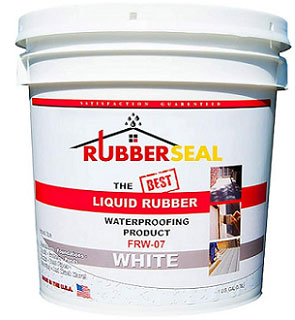
Features
- Insulating Excellence: With its ceramic properties, this coating acts as an insulator, reducing thermal conductivity. This feature makes it particularly suitable for roofs, providing an extra layer of insulation that can contribute to energy savings.
- EPA Energy Star Rated: Recognized for its energy-efficient properties, this product aligns with the standards set by the EPA Energy Star rating, ensuring users of its eco-friendly credentials.
- UV and Aging Resistance: Engineered to withstand the test of time, the Rubberseal coating remains unfazed by UV exposure and the natural aging process, ensuring longevity and sustained protection.
- Low VOC Formula: Prioritizing environmental health, the coating boasts a low VOC (Volatile Organic Compounds) content, minimizing harmful emissions and ensuring indoor air quality remains uncompromised.
- Impressive Elongation: The coating offers excellent elongation, allowing it to stretch and adapt to the natural movements and shifts in the substrate, thereby reducing the risk of cracks or damage.
Applications
From residential roofs to RV roofs, its adaptability ensures comprehensive protection. Moreover, its white color not only offers a clean aesthetic but also reflects sunlight, potentially reducing cooling costs during warmer months.
Pros
- Easy roll-on application
- Energy-efficient and environmentally conscious
- Long-lasting protection against UV and aging
- Suitable for diverse surfaces and environments
- Reflective properties for enhanced energy efficiency
Cons
- May require multiple coats for optimal protection on certain surfaces
- White color might not suit all aesthetic preferences
3. Best Rubberized Foundation Coating For Concrete: Gorilla Waterproof Seal & Liquid Rubber Sealand For Exterior Concrete
Gorilla Waterproof Patch & Seal Liquid Rubber Sealant is a cutting-edge solution designed to fortify surfaces against water, air, and moisture intrusion. With its advanced formulation, this sealant offers a durable and flexible barrier that ensures long-lasting protection against leaks.
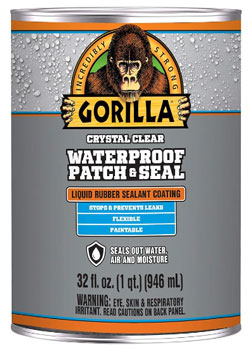
Features
- Versatile Application: This sealant can be applied using various methods such as brushing, rolling, troweling, dipping, or pouring, providing flexibility in application techniques.
- Self-Leveling Formula: Its innovative formulation allows the sealant to smoothly cover minor gaps and cracks, guaranteeing a seamless and watertight seal.
- Durability: Once set, the rubberized coating exhibits remarkable resistance to temperature fluctuations and UV rays, ensuring that repairs stand the test of time.
- Compatibility: It is compatible with a wide range of materials including metal, concrete, wood, aluminum, brick, tile, fabric, rubber, and glass, enhancing its versatility.
Applications
Home Repairs: Ideal for sealing roofs, gutters, skylights, chimneys, PVC pipe joints, windows, and more.
Outdoor Projects: Suitable for use on RVs, DIY projects, and other exterior applications where waterproofing is essential.
Pros
- Its user-friendly application methods make it accessible for both professionals and DIY enthusiasts.
- Its compatibility with various materials broadens its range of applications.
- The sealant’s resilience against environmental factors ensures that repairs remain intact over an extended period.
Cons
- Not suitable for sealing gaps larger than 1/4″, limiting its utility for larger crevices or cracks.
4. Rain Guard All Porous Waterproof Liquid Rubber Foundation Sealant
Rain Guard Pro’s MICRO-SEAL stands as a beacon of modern technology in the realm of protective coatings. Designed specifically for porous wood and masonry surfaces. This water repellent not only enhances the aesthetic appeal but also fortifies surfaces against nature’s harshest elements.
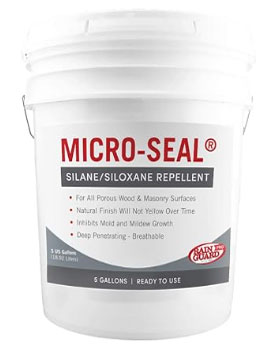
Features
- Deep Penetration: Unlike many conventional sealers, MICRO-SEAL dives deep into the substrate, ensuring thorough protection from within.
- Natural Finish: After application, the surface retains its original texture and appearance, devoid of any artificial sheen or discoloration.
- Broad Spectrum Protection: From harmful UV rays to wind-driven rain and dirt, this sealer forms a formidable shield against various detrimental factors.
- Eco-friendly Formulation: Embracing sustainability, the formula is designed to be safe for both the environment and the user, setting a new standard in responsible construction solutions.
Applications
Ideal for both interior and exterior use. Perfect for a wide range of surfaces including concrete, brick, wood, stone, tiles, and stucco. Suitable for projects of all sizes, from intricate designs to expansive areas.
Pros
- Its compatibility with multiple surfaces makes it a go-to solution for various projects.
- Offers long-lasting protection, ensuring the surface remains pristine for extended periods.
- With its ready-to-use nature, application becomes a hassle-free experience.
- Its eco-friendly composition aligns with the modern demand for sustainable solutions.
Cons
- Proper surface preparation, including cleaning and crack filling, is essential for optimal results.
5. Best Rubberized Foundation Coating For Basement: Ames Water Base Elastomeric Interior Foundation Sealer Liquid Rubber
Ames Block & Wall Liquid Rubber represents a cutting-edge innovation in the realm of construction materials. This liquid rubber is specifically designed to serve as a robust shield against water infiltration, offering unparalleled protection to various surfaces.
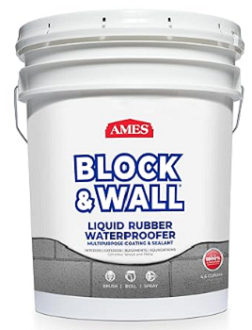
Features
- Superior Elasticity: With a staggering elongation capacity, this liquid rubber can stretch up to 1800% of its original size, ensuring flexibility and resilience against potential cracks.
- Multipurpose Application: Whether it’s concrete, metal, wood, or ICF, this liquid rubber showcases remarkable adhesion and waterproofing capabilities across a wide range of surfaces.
- Ease of Application: Despite its thick consistency, it remains effortlessly applicable. Whether you choose to spray, roll, or brush it on, the process is streamlined for convenience.
- Environmentally-Conscious: Crafted with the planet in mind, Ames Block & Wall Liquid Rubber boasts non-toxic formulations, ensuring safety for both users and the environment.
- American Craftsmanship: Proudly made in the USA, it adheres to stringent quality standards, promising reliability and longevity.
Applications
- Waterproofing: Ideal for safeguarding concrete walls, cinder blocks, and other vulnerable areas from water damage.
- Crack & Crevice Filling: Its thick consistency ensures efficient filling of cracks and crevices, offering an added layer of protection against moisture intrusion.
Pros
- Specially formulated to provide waterproofing for concrete walls, cinder blocks, ICF, metal, wood, and various other surfaces.
- Capable of filling cracks and crevices up to ⅛ inch, enhancing the durability of the surfaces.
- Offers up to 1800% elongation, providing exceptional resistance to cracking and peeling.
- Can be applied using a sprayer, roller, or brush, making it convenient for different application preferences.
- Non-toxic, low odor, and made in the USA
Cons
- Achieving optimal results may necessitate thorough surface preparation, which could be time-consuming.
6. Multipurpose Liquid Rubber Coating, Low VOC & Durable Finish
Discover the BEEST Foundation Sealant, a premium liquid rubber coating that promises to revolutionize your waterproofing endeavors. Specifically formulated for durability and flexibility, this sealant stands out as an exceptional choice for both indoor and outdoor applications.
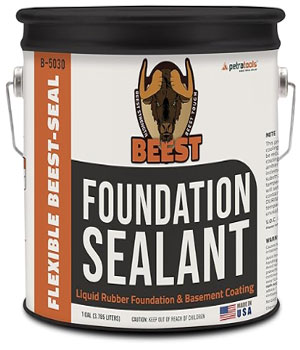
Features
- Robust Protection: This advanced sealant acts as a robust barrier against water, ensuring your surfaces remain damp-proof and free from moisture-induced damage.
- Versatile Composition: Crafted with a blend of low VOC asphalt emulsion and potent polymers, it guarantees resilience against extreme weather conditions and vibrations.
- Flexible Finish: Once applied, the liquid rubber transforms into a tough, flexible coating that is both UV-stable and aesthetically pleasing with its black finish.
- Easy Application: Designed for convenience, it offers hassle-free application, seamlessly adhering to a variety of surfaces from cement to metal.
- Environmentally Conscious: With its low VOC formulation, it minimizes environmental impact while ensuring maximum performance.
Applications
- Foundations, basements, and retaining walls
- Decks, fences, and posts
- Various surfaces including cement, brick, wood, and metal
Pros
- Suitable for a wide range of surfaces and projects, making it a one-stop solution.
- Its tough and flexible finish ensures long-lasting protection against water and other elements.
- A low VOC content aligns with eco-conscious applications.
- With clear application guidelines, it’s ideal for both DIY enthusiasts and professionals alike.
Cons
- Users might need to ensure thorough application, especially when applying at the recommended rate.
Henry HE887HS073 TropiCool5GAL Tropicool Roof Coat
This sealant is similar to Liquid Rubber Foundation & Basement Sealant, but it is also fire-resistant.
the 100% Silicone White Roof Coating is a high-performance solution designed to withstand extreme weather conditions, UV exposure, and potential water-related challenges. Its reflective properties, chemical bond strength, and durability make it an effective choice for maintaining a resilient and energy-efficient roofing system.
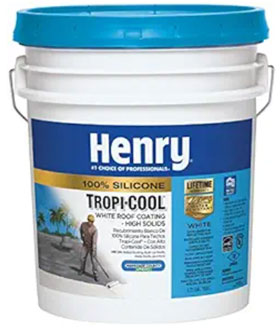
What Is Rubberized Foundation Coating?
Rubberized foundation coating is a waterproofing material that is applied to the exterior of a building’s foundation to protect it from water damage and moisture intrusion. This coating is typically made from a blend of rubber polymers and other additives, creating a flexible and durable barrier that helps to prevent leaks and seepage.
What Is Rubberized Coating?
Rubberized coating is a protective layer made of rubber or rubber-like materials applied to surfaces for enhanced grip, durability, or water resistance.
How Long Does Rubberized Undercoating Last?
The longevity of rubberized undercoating varies based on usage, environment, and quality. Generally, it can last several years, but it’s not typically considered a “lifetime” solution.
What Is The Best Sealant For A House Foundation?
Flex Seal Liquid Rubber Sealant,Rubberseal Liquid Rubber,Gorilla Waterproof Patch & Seal Liquid Rubber Sealant,Rain Guard Pro’s MICRO-SEAL,Ames Block & Wall Liquid Rubber sealants are the best Sealant For A House Foundation.
What Is The Best Sealant For Basement Walls?
Endur-O-Seal offers a 100% pure acrylic solvent sealer, ideal for basement walls. It provides high performance, reduces odor, and imparts a semi-gloss “Wet Look” on various substrates.
How Do You Use Liquid Rubber Foundation Sealant?
To use liquid rubber foundation sealant:
- Clean the foundation surface to remove debris.
- Apply the sealant with a brush, roller, or sprayer.
- Allow it to dry, forming a waterproof membrane.
- Add additional coats as necessary for optimal coverage.
How Many Coats Of Liquid Rubber?
The number of coats needed can vary depending on the specific product and the surface being coated. As a general guideline, applying 2-4 coats of liquid rubber is typically sufficient to create a strong, waterproof seal.
How Long Does Liquid Rubber Last?
Liquid rubber is a durable material that can last for up to ten years when properly applied and maintained. The longevity of liquid rubber largely depends on factors such as the quality of the product, the surface it is applied to, and the environmental conditions it is exposed to.
What Is The Best Liquid Rubber Waterproof Sealant?
Liquid Rubber Basement Sealant offers superior adhesion to various clean surfaces and boasts excellent weathering properties, making it a top choice for waterproof sealing needs.
Liquid Rubber Foundation Sealant – Benefits & Application
Here’s a breakdown of its advantages and how it is typically applied:
Benefits of Liquid Rubber Foundation Sealant
- Waterproofing
- Flexibility
- Durability
- Ease of Application
- Adhesion
- Cost-Effective
- Versatility
Application of Liquid Rubber Foundation Sealant:
- Surface Preparation
- Priming (if required)
- Application: Use a brush, roller, or spray equipment to apply the sealant evenly onto the foundation surface.
Is Rubberized Undercoating Bad?
Rubberized undercoating is not inherently bad; it can protect vehicles from rust and noise.
What Is Sealant Used For?
Sealant is used to fill gaps, joints, or seams, preventing air, water, dust, or pests from entering. It provides protection and improves aesthetics in various applications.
Why Are Sealants Important In Construction?
- Protection: Sealants prevent water infiltration, reducing the risk of moisture damage.
- Durability: Extend lifespan by sealing joints, preventing wear and tear.
- Energy Efficiency: Reduce air leakage, enhancing building insulation.
- Aesthetic Appeal: Enhance appearance by filling gaps and cracks.
- Sound Control: Minimize noise transmission between spaces.
- Flexibility: Allow for movement in building materials without compromising integrity.
- Safety: Sealants can act as fire barriers, enhancing building safety measures.
- Cost Savings: Prevent potential costly repairs due to water damage or energy loss.
- Sustainability: Sealants can improve a building’s energy efficiency, reducing environmental impact.
Read More About 8 Best Lubricants For Garage Doors to Keep Your Garage Door Silent and Efficient
Why Is Air Sealing A House Important?
- Reduces energy costs.
- Improves indoor air quality.
- Enhances comfort and temperature consistency.
- Minimizes drafts and cold spots.
- Prevents moisture and mold issues.
- Increases HVAC efficiency.
- Extends building durability.
- Enhances sound insulation.
- Reduces pests and insects entry.
- Improves overall building performance.
Why Do You Use Sealant?
Sealant is used to fill gaps, joints, or seams, preventing air, water, dust, or other substances from passing through, ensuring protection, durability, and improving aesthetics.
The Importance of RV Liquid Roof Sealant on Your RV Roof
- Protection: Shields against UV rays, preventing roof degradation.
- Waterproofing: This creates a seamless, watertight barrier, preventing leaks.
- Durability: Resists cracking and peeling, ensuring long-lasting protection.
- Cost-effective: Reduces maintenance costs by preventing major repairs.
- Energy Efficiency: Reflects sunlight, reducing interior temperature and cooling costs.
- Ease of Application: Simple to apply, reducing labor costs.
What Is The Use Of Roof Sealant?
Roof sealant is used to protect roofs from water damage, prevent leaks, and extend the lifespan of the roofing material by sealing gaps and cracks.
What Is An RV Seal?
An RV seal refers to a weatherproofing or sealing component used in recreational vehicles (RVs) to prevent water, air, or other elements from entering or exiting, ensuring the interior remains protected and comfortable.
How Do You Apply Liquid Rubber To Foundation?
Preparation
- Clean the foundation surface thoroughly, removing any dirt, dust, or debris.
- Ensure the surface is dry before applying the liquid rubber.
Tools & Materials
- Liquid rubber sealant.
- Paintbrush or roller suitable for liquid application.
- Protective gloves and goggles.
Application
- Stir the liquid rubber thoroughly before application.
- Start at the top of the foundation and work downwards.
- Apply a thin, even coat using a paintbrush or roller, ensuring no gaps or bubbles.
- Allow the first coat to dry as per the manufacturer’s instructions.
Additional Coats
- Apply subsequent coats as needed for desired thickness and coverage.
- Ensure each layer is fully dried before applying the next.
Curing
Allow the final coat to cure completely as per the product guidelines before exposing it to water or other elements.
How Do You Remove Liquid Rubber?
Here are some general steps and methods you can consider:
Mechanical Removal
- Scraping: If the liquid rubber is not fully cured, you can try scraping it off using a putty knife or scraper. Be careful not to damage the underlying surface.
- Sanding: For small areas or thin layers, sanding might be an option. Use coarse sandpaper initially, followed by finer grits to smoothen the surface.
Chemical Removal
- Solvents: Common solvents might include acetone, xylene, or mineral spirits. Test the solvent on a small, inconspicuous area first to ensure it doesn’t damage the surface.
- Commercial Cleaners: There are commercial adhesive removers or cleaners designed to break down and remove various sealants and coatings. Again, always test on a small area first.
Read Also 9 Best Lock On Grease Coupler for Effortless Lubrication Ultimate
Ultimate Liquid Rubber Foundation Sealant Buying Guide: Choose Wisely for Superior Protection
This comprehensive buying guide will walk you through key considerations and features to ensure you make an informed choice for ultimate protection.
1. Application Methods:
Consider your preferred application method – brushing, rolling, dipping, or pouring. Choose a sealant that adapts seamlessly to your needs, ensuring a hassle-free application process.
2. UV Resistance:
Look for a sealant with excellent UV resistance. This feature ensures longevity and durability, making it ideal for outdoor applications where exposure to sunlight is constant.
3. Chemical Resilience:
Assess the sealant’s resistance to chemicals. A reliable product should prevent corrosion, maintaining the coated surface’s integrity against various environmental factors.
4. Color Range:
Evaluate the available color options. Whether black, white, clear, or gray, choose a color that suits your aesthetic preferences and complements the surroundings.
5. Insulating Excellence (if applicable):
If insulating properties are important, opt for a sealant with ceramic properties that reduce thermal conductivity. This is particularly beneficial for roofs, providing an extra layer of insulation.
6. Environmental Considerations:
Prioritize environmentally conscious options with low VOC (Volatile Organic Compounds) content. Choose sealants that align with eco-friendly practices without compromising performance.
7. Versatility:
Consider the sealant’s compatibility with various surfaces. Versatility is key, ensuring that the product can be effectively applied to different materials such as concrete, metal, wood, and more.
8. Ease of Use:
Assess the ease of application. Whether you’re a professional or a DIY enthusiast, choose a sealant that offers user-friendly application methods, whether it’s rolling, brushing, or spraying.
9. Elongation:
Look for a sealant with impressive elongation capabilities. This allows the product to stretch and adapt to natural movements in the substrate, reducing the risk of cracks or damage over time.
10. Price:
Consider your budget. While it’s essential to prioritize quality, finding a balance between effectiveness and cost is key. Compare prices among top-rated products to make an informed decision.
FAQs
What is Liquid Rubber good for?
Liquid Rubber is good for waterproofing, sealing roofs, ponds, and foundations. It provides durable protection against leaks, corrosion, and environmental damage.
Is Liquid Rubber permanent?
Liquid Rubber forms a durable, long-lasting bond, but its permanence depends on application, conditions, and use. It’s designed for lasting protection and can bond permanently in specific contexts.
How long does Liquid Rubber Waterproof Sealant last?
Liquid Rubber Waterproof Sealant typically lasts 10 years, providing durable waterproofing protection for various surfaces such as roofs, foundations, and ponds.
Where to buy rubberized foundation coating?
You can buy rubberized foundation coating at hardware stores, home improvement centers like Home Depot or Lowe’s, online retailers such as Amazon, or specialty roofing suppliers.
What sealant is used on an RV?
Silicone RV sealants are commonly used on RVs to seal gaps and prevent water leaks. They provide flexibility and durability suitable for various outdoor conditions.
Should I seal my RV?
Yes, sealing your RV protects against leaks, reduces maintenance costs, and extends its lifespan. Regular sealing prevents water damage and ensures better insulation.
Can you paint over liquid rubber foundation sealant?
Yes, liquid rubber foundation sealant can be painted over. Ensure the surface is clean and dry before applying paint for best adhesion and durability.
Conclusion
Liquid rubber foundation sealants have revolutionized the way we protect our buildings and structures from water damage and environmental factors. With their unparalleled flexibility, durability, and ease of application, these sealants have become indispensable tools for both professionals and DIY enthusiasts alike. We hope you find the best liquid rubber foundation sealant for your needs!




![Can I Use Foam Sealant For Gaps In Shower Fixtures [Proper Guide]](https://glueanswer.com/wp-content/uploads/2024/01/Can-I-Use-Foam-Sealant-For-Gaps-In-Shower-Fixtures-Proper-Guide-768x432.jpg)

